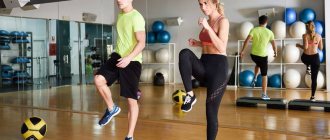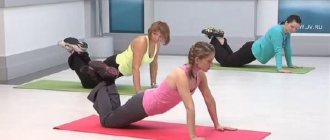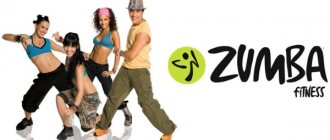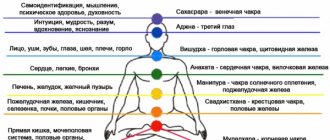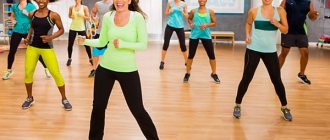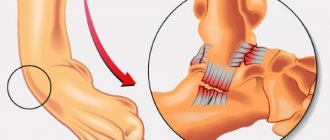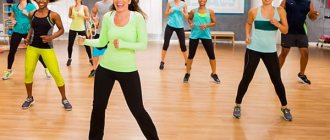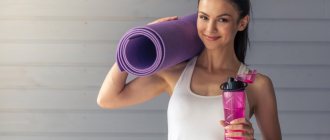© Microgen — stock.adobe.com
Share:
Tai Bo is an aerobic program that combines punching and kicking with escapes and dance steps. The name comes from a combination of “taekwondo” and “boxing,” but in reality the program most closely resembles Muay Thai punches and basic aerobics.
The lesson is quite old, the author of the original program is Billy Blanks, who founded the first training center using this method. The birth of this type of fitness is quite well mythologized. There are stories on the Internet that Billy starred in a movie with Bruce Lee. In reality, everything was much more prosaic.
The essence of tai bo
What kind of lesson is tai-bo and what is its peculiarity? The author of the program simply decided to make money on the cult of thinness that covered America in the 80s. He happened to be at the right time, where Pamela Anderson and Paula Abdul were coming out, and correctly understood the desires of the target audience. The women wanted to finally start eating normally at least sometimes. But ordinary aerobics from Jane Fonda did not give them such an opportunity. An hour of dancing in swimsuits and leg warmers and minus a measly 300-400 kcal. Who will be happy with this?
Billy decided to use his experience as a karateka and mass entertainer. Contrary to popular stories in RuNet, he did not act with Bruce Lee, but was his fan. Just a guy from a large family who did karate, then ended up in Hollywood as a stunt choreographer in low-profile films, and then made a fortune from people’s love of food.
Tai-bo allows you to “remove” up to 800 kcal in an hour , because all the blows are quite intense, and exits are performed through soft jumps. The point is that for an hour the student beats an imaginary opponent in all available ways - with legs, arms, elbows, knees, and so on. It's much more fun and interesting than many other aerobic classes. Billy quickly became a star.
But he was a much worse businessman than the “father” of CrossFit, Greg Glassman. Billy was able to create a program, release a series of training videos, which were quickly published in open sources, and become a celebrity trainer. But he couldn’t sell the franchise. If you go to a tai bo class somewhere in central Russia, most likely the lesson will be created by a local group program trainer and will only be based on popular martial arts strikes.
Tai-bo is very similar to fitbox, but these are different lessons, their main differences are presented in the table below:
| Tai-bo | Fitbox |
| Without equipment | The blows are delivered to the bag or “paws” |
| No jumping jacks or burpees, only soft jumps and jumps allowed on most levels | Jumping jumps and burpees are often included in the strength part of the lesson; they are used to pump up explosive strength. |
| Part of the lesson is devoted to pumping up the abs and exercises on the floor. | Depends on the instructor, the lesson can be simple, interval, with or without strength training |
| Contains quite a lot of simple aerobic steps - side to side, grapevine, forward-backward steps | Completely based on boxing footwork, jumping back and forth |
History of origin of tae bo
Billy Blanks
The Tai Bo technique was developed in the late eighties of the last century by Billy Blanks, a seven-time martial arts champion. As is usually the case with the creators of the best fitness methods, Billy was weak as a child, or rather, he was born with an abnormality in the hip joint. The guy began his sports career only at the age of eleven, but quickly caught up with his peers and won many awards, among them: five black belts in various martial arts, victory in seven world karate championships. In the eighties, Blanks worked in Hollywood as an actor and fight director. In 1989, he opened his own sports center, where he taught his new development - tai bo. Soon the number of fans went beyond America thanks to Blanks' video training, and his brainchild was adopted by most fitness clubs around the world.
Tai Bo Training Basics for Beginners
Tai Bo is considered an appropriate class for an overweight beginner, but this is not entirely true. People with a BMI over 30, poor posture and weak core muscles should first undergo a general physical training course. They should do Pilates and an elliptical machine 3-4 times a week before starting intense shadow pounding. This will help protect against ankle and knee problems that plague beginner aerobics enthusiasts in heavy weight classes.
Everyone else should understand that:
- You can practice at home using a video if you have normal body control, lifting your leg does not put you on the nearby sofa, and you have enough motivation to practice on your own.
- It is better for those who have problems with self-discipline to join the group.
- It is better to train 2-3 times a week if the goal is to burn fat, increase mobility, endurance and improve health.
- As an addition to strength and cardio training, you can attend tai bo once a week.
- It is better to choose a class that you will have time for. In terms of content, they are not as different as dance or step classes.
© Microgen — stock.adobe.com
Contraindications
Tai bo places significant stress on the spine. The lesson is contraindicated for those with severe scoliosis. It’s worth visiting an orthopedist; if you can’t jump and run, you should also abstain from tai bo.
The remaining contraindications are standard:
- Injuries of the musculoskeletal system during the recovery stage;
- Exacerbation of chronic diseases;
- ARVI, ailments;
- Severe disorders of the cardiovascular system
Can pregnant women practice tai bo? In the “Soviet” school of gynecology we are told that under no circumstances. Kicking can cause uterine tone, while punching can simply be uncomfortable due to the changing center of gravity. Meanwhile, there are special video lessons with elements of tai bo for pregnant women. They take into account body features and contraindications to the use of kicking techniques, and focus on breathing, arm work, and aerobic steps.
Obesity may be a contraindication if a person has poor coordination of movements. People who are simply overweight can exercise, but should not actively jump. The most likely injury for these people is an ankle injury. Therefore, it is recommended to rest while walking with the knee raised high.
How to avoid overtraining? Those who want to lose weight quickly manage to practice tai bo every day for a couple of hours. This should not be done simply because it causes overwork of the central nervous system, and can cause injury due to lack of coordination. To lose weight, it is enough to exercise 3 hours a week if no additional load is performed, or 1-2 hours if the exercises are supplemented with strength work.
Important: Drink clean water during training to avoid dehydration.
Does tai bo develop endurance?
Tai-bo develops endurance, as it consists of multiple repetitions of the same type of work . Punches and kicks are combined into chains; the group performs series rather than single strikes. True, such endurance will be more useful for “life” and as general physical training before moving on to boxing or martial arts.
Such lessons do not provide much in terms of strength endurance. So if your goal is to get better at the gym or CrossFit, you should do it.
Endurance development
In order not to get bored during a group lesson and not fall from fatigue, you will have to increase your endurance before your first tai bo lesson.
Ideally, a person taking this lesson should be able to jog about 3 km at a pace of 6-7 minutes per kilometer. Such “skills” will allow you not to choke and actually move actively.
The first month in the gym should be spent with 3-4 40-minute cardio workouts. You need to pedal an exercise bike or walk on a treadmill with a slight incline. The main task is to go through the entire time period with sensations of average load. You can evaluate it by pulse zones, sticking to 60-70% of the maximum heart rate, or you can also estimate it by sensations. You need to sweat a little, but be able to carry on a conversation.
About a month of such work will provide a sufficient basis for training tai bo.
Important: treadmills and exercise bikes can be replaced by regular walking down the street
Positive aspects of tai bo
The lesson gives a lot of positivity, because you will beat your imaginary enemy with a crowd of comrades. Isn’t this what we all dream about when we’re stuck in a traffic jam, sitting in a meeting, or doing the same type of low-paying job?
But, seriously, this is a good option for “pumping up” your health:
- relieves stress and emotional tension;
- pumps the heart, and in a fairly high-impact mode;
- improves vascular trophism;
- increases joint mobility and ligament elasticity;
- improves motor skills - stretching and coordination of movements.
Tai-bo can also contain elements for actively pumping up the abs or a small series of strength exercises. Billy Blanks' original videos feature moves with light weights, like a short body bar. But this lesson cannot be called a power lesson.
Technique for performing individual elements
Technical excellence is not required in Tai Bo. You should maintain a neutral back, that is, shoulder blades pulled toward the spine, a tucked stomach, a slightly tilted pelvis forward, and “soft” knees.
Initial stance
The feet are slightly wider than the shoulders, the weight is in the center of the body and is projected in the center of the arch of the foot. Initially, the back is straight, the shoulder blades are pulled towards the spine. Before practicing striking techniques, it is worth slightly rounding your shoulders forward to ensure the movement of the joints in a safe trajectory.
© Africa Studio— stock.adobe.com
Straight punch with left and right hand
Also known as a jab, it is performed with a hand that is aligned with the forward leg. You need to stand apart, bring your right leg forward, bring your arms to your shoulders and perform a short sharp blow with your right hand forward. The legs are changed with a slight jump, and a left-sided kick is performed in the same way.
Side kick with left and right hand
Three side impacts:
- An uppercut - that is, a blow from bottom to top, to the jaw, is performed from a straight stance along an elliptical trajectory with a turn of the body.
- A cross is a strike from the far hand in a straight strike stance, it is performed with a turn of the supporting “back” leg and is aimed at the body. The cross should be a strong blow due to the inertia of the body.
- Hook - a side blow with the near hand to the head from shoulder level. In the original lessons, tai bo is used quite rarely, since Billy does not recommend raising your shoulders high during aerobics.
© Africa Studio— stock.adobe.com
“Leave” (slope) left and right
Grooming is the transfer of weight from one leg to the other while simultaneously moving the body towards the loaded leg. It looks like a “pendulum” with its body from left to right and vice versa. One learns from the “feet wider than shoulder width” stance; first a person learns to bend along an arcuate path without transferring weight to the leg, then with transfer. The second level is walking with a chain of additional steps, then the tilt of the body is repeated several times in the same direction in which the steps are performed.
What is this in fitness?
Tai-bo is a workout specially designed for fitness clubs that combines simple choreography, a large number of movements, rhythmic music and the ability to adjust the intensity of the workout depending on the level of training. Tai-bo training combines exercises from taekwondo and karate with elements of dance movements to lively music, as well as practiced boxing strikes. The developer of a new direction in sports is Billy Blanks. The main emphasis in the exercises is on kicks and punches.
Combining different types of martial arts helps improve coordination, develop endurance and punching power, and burn a lot of calories.
It is impossible to build up muscle mass with aerobic exercises, but you can lose weight and make your muscles more prominent. Therefore, girls and women prefer tai-bo cardio exercises in order to get rid of extra pounds without the risk of spoiling the body proportions with overly inflated shoulders or oblique abdominal muscles. Men choose tai bo to burn subcutaneous fat and define their muscles more clearly.
Benefits of practicing tai bo:
- Improves endurance and strengthens the heart muscle.
- Cardio training without jumping and injury to joints.
- Prevention of osteochondrosis, strengthening the spine and forming an even posture.
- Burning calories and subcutaneous fat without losing or gaining muscle mass.
- Development of the muscles of the legs and abdomen due to the active work of the abs, tightening flabby arms.
- Improved coordination, stretching and balance.
- Increasing mood by relieving negative emotions.
- Possibility to exercise at home, as no sports equipment is required.
- Suitable for beginners due to the simplicity of the program and basic exercises.
In addition, systematic exercise will help not only strengthen the body as a whole, but also strengthen the immune system, improve reaction, and also develop the vestibular apparatus.
Kicks
Kicks are used in every workout.
Strike with the right and left knee
Knee strikes in Tai Bo are the closest to how Muay Thai strikes are done. The kicker transfers his body weight to one leg, releases the other, bends it at the knee joint and brings the knee to the shoulder of the same name. In the aerobic lesson, this kick has the format “standing exercise to pump up the abs.”
© Microgen — stock.adobe.com
Kick back
The back kick is performed as a hip extension with additional force from the knee. You need to transfer your body weight to the supporting leg, release the kicking leg and strike back with your heel, sharply extending your leg at the knee.
Kick forward
Learning to strike begins with bringing the knee forward, then adding extension in the knee joint and striking the heel forward.
Kicks to the side
Side kick - after transferring the weight to the supporting leg, a kick is performed from the knee to the side, the heel goes to the side, the body leans in the opposite direction.
Rond, or roundhouse, is similar to the side one, only the movement of the heel goes “from the inside out”, in an arc. The blow falls to the body or head.
Description
Tai-bo is a type of cardio training that can be done both at home and in the gym. Classes include elements of martial arts, dance moves and step aerobics. All exercises are aimed at losing weight and strengthening muscles. The training program is suitable not only for women and girls, but also for men who want to dry out subcutaneous fat. The aerobic program is suitable for people with different levels of training, including beginners. The workouts are energy-intensive, requiring a lot of effort and endurance, but they are also effective, since you can burn from 500 to 900 kcal in an hour of training.
Bundles of elements
To warm up in tai-bo, a slightly modified aerobic combination can be used - two additional steps to the right and left and swings of the arms along the body, plus two additional steps to the right and left and synchronized forward punches.
The most commonly used combinations in tai-bo are:
- “Jab, cross, hook, uppercut,” that is, a direct blow, for example, with the right hand, a side left, a side “finishing” with the right and from bottom to top with the left.
- Two blows with the left knee, a combination of hands with the right, jump, repeat with the other leg.
Tempo links will help increase intensity:
- 30 seconds of very fast running with high knees, 30 seconds of very fast forward punches while standing, the same amount of low straight kicks with alternating legs.
- 30 seconds of side punches, 30 seconds of uppercuts with a quick change of hands in the stance.
- 30 seconds of back kicks with changes, 30 seconds of side kicks with changes.
The tempo link works at the end of the workout.
An hour-long class from Billy Blanks himself:
Recipes for healthy eating
Champignon, chicken and egg salad
- 14.5 g Protein
- 16.5 g Fat
- 2.3 g Carbohydrates
- 205.2 kcal
40 min.
- #polka dots
- #mushrooms
- #corn
- #chicken
- #poultry
- #dinner
- #Chinese cabbage
- #tomato
- #vegetable oil
- #sour cream
- #cheese
- #dinner
- #Champignon
- #egg
Other recipes



